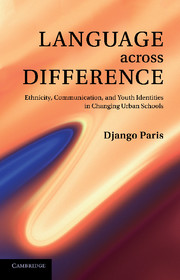Book contents
- Frontmatter
- Contents
- Figures
- Tables
- Acknowledgments
- 1 Beginnings: shouts of affirmation from South Vista
- 2 ‘Spanish is becoming famous’: youth perspectives on Spanish in a changing youth community
- 3 ‘True Samoan’: ethnic solidarity and linguistic reality
- 4 ‘They’re in my culture, they speak the same way’: sharing African American Language at South Vista
- Interlude : on oral language use, research, and teaching in multiethnic schools
- 5 ‘You rep what you’re from’: texting identities in multiethnic youth space
- 6 Making school go: re-visioning school for pluralism
- Appendix: Notes on methodology in cultural studies of language across difference
- Notes
- References
- Index
6 - Making school go: re-visioning school for pluralism
Published online by Cambridge University Press: 05 August 2011
- Frontmatter
- Contents
- Figures
- Tables
- Acknowledgments
- 1 Beginnings: shouts of affirmation from South Vista
- 2 ‘Spanish is becoming famous’: youth perspectives on Spanish in a changing youth community
- 3 ‘True Samoan’: ethnic solidarity and linguistic reality
- 4 ‘They’re in my culture, they speak the same way’: sharing African American Language at South Vista
- Interlude : on oral language use, research, and teaching in multiethnic schools
- 5 ‘You rep what you’re from’: texting identities in multiethnic youth space
- 6 Making school go: re-visioning school for pluralism
- Appendix: Notes on methodology in cultural studies of language across difference
- Notes
- References
- Index
Summary
We are in the middle of an extraordinary social experiment: the attempt to provide education for all members of a vast pluralistic democracy. To have any prayer of success, we’ll need … a philosophy of language and literacy that affirms the diverse sources of linguistic competence and deepens our understanding of the ways class and culture blind us to the richness of those sources.
Mike Rose, Lives on the BoundaryA vast question loomed over all of my learning with the youth of South Vista, as it now looms over the closing chapter of this book: what is the purpose of schooling in a pluralist society? The history of schooling in the United States, a country home to epic linguistic, racial, and cultural diversity, has traditionally defined this purpose rather clearly. The purpose of schooling has been to transition or mainstream the ways of knowing and being of those whose cultures and languages fall outside the dominant stream into White, DAE, middle-class norms. Yet volumes of research and theorizing in the past three decades have profoundly challenged these narrow assimilatory goals. This work has critiqued both the unsatisfactory academic results for young people of color and the perpetuation of racial and cultural bias through assimilatory models of education.
- Type
- Chapter
- Information
- Language across DifferenceEthnicity, Communication, and Youth Identities in Changing Urban Schools, pp. 163 - 174Publisher: Cambridge University PressPrint publication year: 2011

